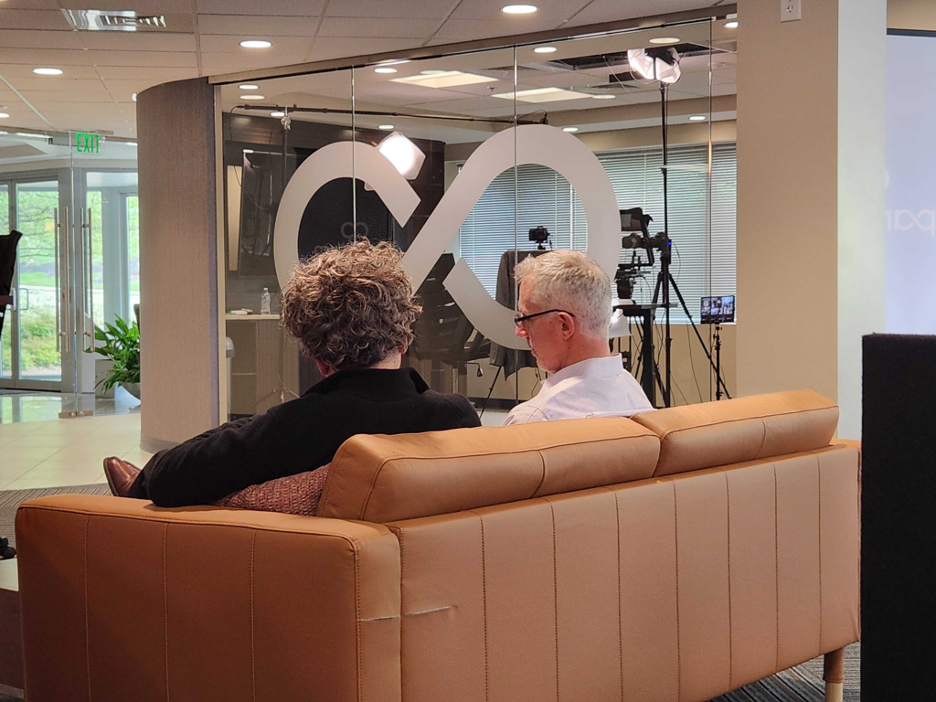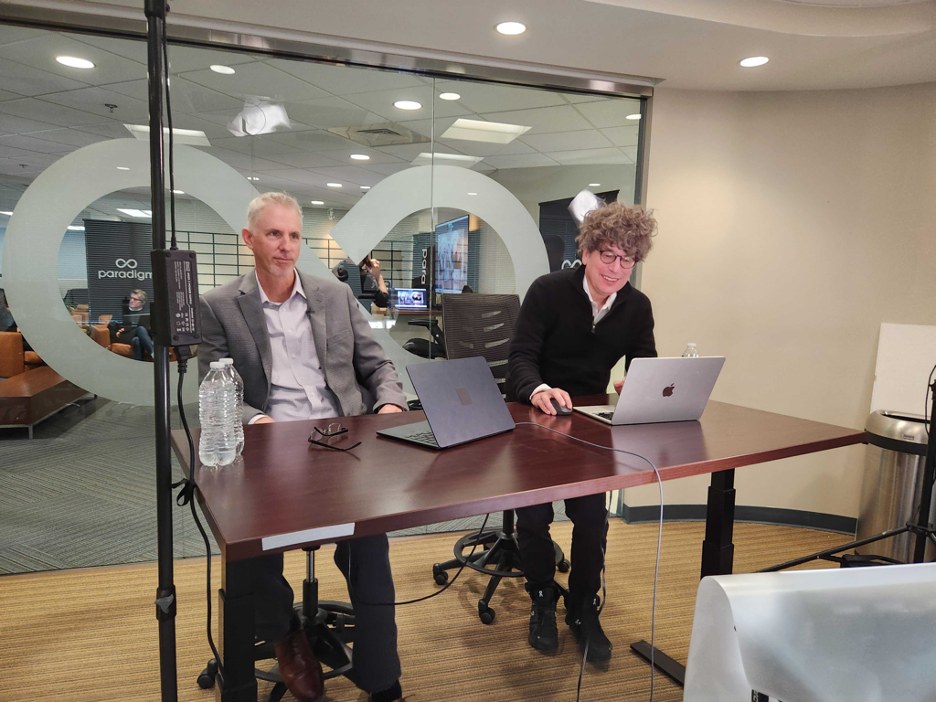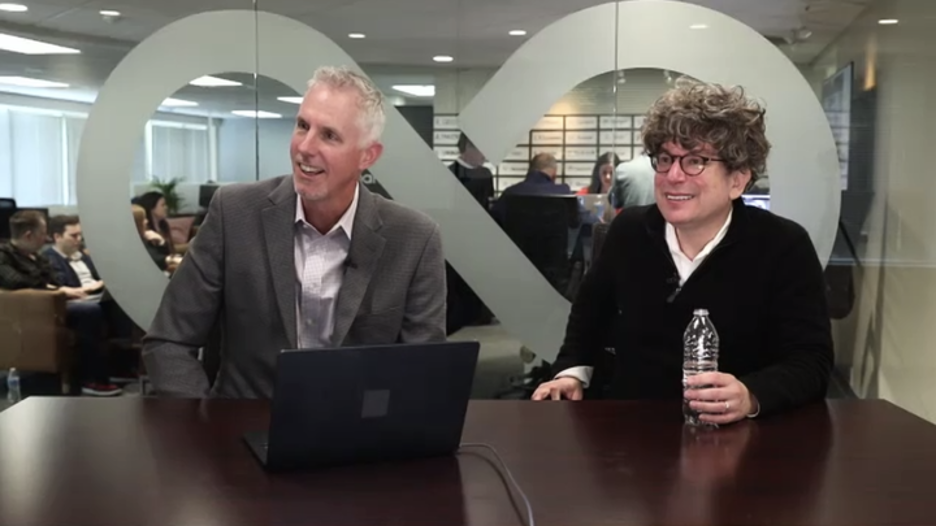The New Diversification
![]() Not Your Father’s Diversification
Not Your Father’s Diversification
 “I don’t normally leave the house,” joked iconoclast investor James Altucher during our live event yesterday, streamed from Paradigm’s new headquarters just outside Baltimore.
“I don’t normally leave the house,” joked iconoclast investor James Altucher during our live event yesterday, streamed from Paradigm’s new headquarters just outside Baltimore.
James' assertion, by the way, can’t be true since he mentioned he’d recently spoken at events in Texas and Utah and will be traveling to another in Norway two weeks hence.
But our team — including Paradigm’s VP of Publishing Doug Hill — were delighted to host James for what turned out to be a rousing hour-plus conversation, punctuated by giveaways of $1,000 to 75 lucky Zoom participants.

Courtesy: Jessica Zeller
James Altucher and MC Doug Hill prepare for the live Zoom call… 
Courtesy: Jessica Zeller
Another peek behind the scenes…
Shortly on the heels of kicking off the event, James mentioned: “Inflation looms over our economy, we have this bottomless national debt and two hot wars.” Indeed, it is enough to make you want to hide out at home.
Instead…
 “Look at all this volatility… and learn how to be calm as an investor,” James urges. For that, he advocates for diversification. But this isn’t your father’s diversification…
“Look at all this volatility… and learn how to be calm as an investor,” James urges. For that, he advocates for diversification. But this isn’t your father’s diversification…
“When people get nervous about current events,” he says, “you could see gold spike. Lately, Bitcoin has served this purpose, as a store of wealth or a flight to safety.”
He points to countries adopting Bitcoin, including El Salvador; he also mentions a groundswell of support in Switzerland to allow crypto to be added to central bank reserves.
“Real diversification now is having diversified alternative strategies,” James says. “It’s good to have multiple uncorrelated strategies.” To wit, stocks tend to rise and fall together.
So when a Zoom participant asked how much crypto to allocate in a typical portfolio, James recommended 5–10%. (Much like Jim Rickards’ gold allocation.) “Risk management is critical,” he cautions. As for altcoins, James says he likes to invest in 15–20 coins (but no meme coins for him).
 Regardless of volatility, James believes: “This is a very interesting time because we’re in the sweet spot for crypto, the sweet spot for AI.”
Regardless of volatility, James believes: “This is a very interesting time because we’re in the sweet spot for crypto, the sweet spot for AI.”
And James didn’t disappoint yesterday…

He promised to give away three tickers for viewers’ consideration. Instead, he shared five — running the gamut from altcoins to microcap stocks.
In short, James says: “Try to stay focused on making money” and don’t allow fear to “override” the desire to protect your family’s wealth.
[Former hedge fund manager James Altucher says: “I’d rather help 20,000 people learn about investing rather than help 20 millionaires make more money.”
For a brief window, you can watch a rebroadcast of James’ wide-ranging conversation. It’s not to be missed! But the link goes dead on Sunday at midnight.]
![]() Inflation Drifts Away From Fed’s Target
Inflation Drifts Away From Fed’s Target
 The Commerce Department came out this morning with “core PCE” — the Federal Reserve’s preferred measure of inflation. When people at the Fed speak of their 2% inflation target, it’s core PCE they’re talking about.
The Commerce Department came out this morning with “core PCE” — the Federal Reserve’s preferred measure of inflation. When people at the Fed speak of their 2% inflation target, it’s core PCE they’re talking about.
For all practical purposes, inflation is once again drifting away from the 2% target. Core PCE was up a “brisk” 0.3% in March to 2.8% year-over-year. Among dozens of economists polled, the average guess was a slightly lower 2.7%.
“There’s both a story here about the economy holding up very well with high interest rates, as well as inflation pressures being persistent,” says an optimistic JPMorgan economist Bruce Kasman.
“And while I don’t think it’s right to talk about this from the point of view of Fed tightening, I think the case for Fed easing here is pretty small anytime soon,” Kasman concedes.
We’ll have more on the Fed’s clownery and Wall Street’s fairytale in a moment…
 Two tech titans reported Q1 earnings yesterday afternoon.
Two tech titans reported Q1 earnings yesterday afternoon.
Namely, Alphabet (Google’s parent company) reported an earnings beat, citing demand for its new AI contributions. Plus, for the first time in the company’s history, Alphabet announced a dividend of $0.20 per share on Class A, B and C stock to be disbursed on June 17. Google shares are up about 10% today.
And Microsoft shares have bounced a modest 2.4% after the company announced its own earnings beat — again, attributed to its AI products.
With that, the tech-heavy Nasdaq index is catching a bid, gaining 2.15% and approaching 16,000. Meanwhile, the S&P 500 index is up 1.15% to 5,100 while the staid Dow is up 0.55% to 38,290.
Turning to the commodities complex, oil is in the green, up 0.55% to $84.05 for a barrel of West Texas Intermediate. Gold is up a modest 0.15% to $2,334.90 per ounce, but silver’s down 0.75% to $27.18, according to Kitco.
The crypto market is in the red today: Bitcoin’s lost 1.55% to $63,600 while Ethereum’s down 1.25% to $3,115.
![]() “Stagflation, Anyone?”
“Stagflation, Anyone?”
 “They were wrong, we were right,” Paradigm’s macro expert Jim Rickards says.
“They were wrong, we were right,” Paradigm’s macro expert Jim Rickards says.
“We’ve written for months that there would be no interest rate cut by the Fed at their June meeting. Wall Street was putting the odds of a rate cut at around 70% and the stock market was rallying, anticipating the cut.” (See above.)
Yesterday? “Every Wall Street analyst was proclaiming there will be no rate cut in June, maybe not in July either,” Jim says. “[Their] forecast came after the market had already corrected… That’s worthless forecasting, but it’s what Wall Street does best.
“Early 2023 was Wall Street’s target date for the ‘pivot,’” he recollects. “That never happened. Moving the pivot date from June 2024 to later this year is just their latest blunder.
“Now there is a chance that we won’t get any rate cuts this year…
 The Fed wants to see inflation start coming down in a persistent manner, but the market wants to see economic growth and corporate profits increasing,” Jim adds.
The Fed wants to see inflation start coming down in a persistent manner, but the market wants to see economic growth and corporate profits increasing,” Jim adds.
“If neither is headed in the right direction, then that’s going to be bad news for markets,” he notes. “With inflation actually rising in the latest report and economic growth slowing down with yesterday’s GDP report, this is exactly what is happening.
“Behind Powell’s carefully laid plans and the markets’ Goldilocks-type assumptions lies a huge fallacy. The assumption is that interest rates and inflation have a reciprocal relationship. Markets and the Fed both assume that current high interest rates will tame inflation, and that will pave the way for rate cuts, stronger growth and higher stock prices. But there’s no evidence for this.
“History teaches that there is no inverse correlation between interest rates and inflation…
- The Great Depression (1929–1933) was a period of low interest rates and unprecedented deflation
- The Great Inflation (1977–1981) was a period of high interest rates and record-high inflation.
“We could be looking at the worst of all possible worlds,” Jim says. “We are now seeing slowing growth and higher inflation at the same time…
 “Stagflation, anyone?” he posits, by which the economy stagnates but inflation continues to ravage everyday folks’ finances.
“Stagflation, anyone?” he posits, by which the economy stagnates but inflation continues to ravage everyday folks’ finances.
“We’re back to the conundrum that has faced the Fed since they stopped raising rates last July,” Jim concludes.
“The Fed is reluctant to cut rates because it might fuel inflation. At the same time, the Fed is reluctant to keep rates too high because it might cause recession (which may be already here)
“I’ve been saying for months that a recession is imminent,” Jim warns. “GDP numbers reflect that the economic engine is slowing down.”
Meanwhile, Wall Street continues to spin a “narrative designed to lull investors into complacency and into buying more stocks.
“Wall Street is following the Fed. And the Fed is using bad models that are consistently getting their forecasts wrong,” Jim concludes.
“It’s the blind leading the blind.”
![]() The AI-Deal Brew
The AI-Deal Brew
 A Finland-based company has created the “world's first artificial intelligence coffee.”
A Finland-based company has created the “world's first artificial intelligence coffee.”
Kaffa Roastery partnered with local AI startup Elev to design coffee that’s “a testament to the harmonious blend of technology and tradition, offering a sophisticated and multi-layered experience in every cup,” Kaffa Roastery says.

Courtesy: kaffaroastery.fi/en
“AI-Conic”: Heh, punning IS universal
Elev used large language model (LLM) AI to input data provided by Kaffa’s master roasters to mix beans from four different countries: Brazil (40%), Colombia (25%), Guatemala (25%) and Ethiopia (10%).
According to Kaffa Roastery’s founder Svante Hampf, AI’s four-bean mix is a surprising departure from the typical two-to-three bean blends. The result is “juicy and dynamic. A well balanced blend of sweetness and ripe fruit,” the company’s website says.
“After the first test roasting and blind testing, Kaffa’s coffee experts agreed,” the AP reports, “the tech-assisted blend was perfect, and there was no need for human adjustments.”
And the Finns know their coffee.
With a population roughly equivalent to metro Atlanta, the Nordic nation consumes the most coffee in the world: 26.5 lbs per capita annually. Must need a pick-me-up in the “Land of the Midnight Sun”!
AI to the rescue?
![]() (Circadian) Rhythm Is Going to Get You
(Circadian) Rhythm Is Going to Get You
 “I’m thrilled that the financial industry is finally catching up with us working grunts!” says a first-time contributor about a 24/7 stock market. “I’m in the medical field, very much used to working odd hours including nights and weekends.”
“I’m thrilled that the financial industry is finally catching up with us working grunts!” says a first-time contributor about a 24/7 stock market. “I’m in the medical field, very much used to working odd hours including nights and weekends.”
Another contributor agrees: “Yes, that would work great for me as I’m 12 hours ahead of the market. I live in the Philippines and currently trade until around midnight then go to bed hoping my trades work out.”
Still another reader writes in: You can’t fight city hall… or your innate circadian rhythm.
 “I have been living in the U.S. Central time zone and trading futures for about 15 years. As you know those markets went electronic to 23/5 about 10 years ago.
“I have been living in the U.S. Central time zone and trading futures for about 15 years. As you know those markets went electronic to 23/5 about 10 years ago.
“Depending on the market, I have tried different trading patterns. Gold, for example, will often move following Far East market opens. My circadian rhythm could never adjust comfortably to that schedule.
“Even though the federal bond market trades 23/5, the major bond futures market volume moves occur within about an hour before and an hour after the NYSE open. That has proven workable for my wide-awake trading style.
“Of course, we can trade with cash 24/7. We have been doing that forever, and the facsimiles, first checks and then credit cards, worked mightily to compete with cash. They have done that well, as long as there is electricity available.
“I believe that major trades are initiated by human traders. Bots are everywhere, but I sense that they largely ape human trades and trends. We trader optimists still get up in the morning, get our bearings and trade while we are fresh.
“My own experience tells me that even though there is now a worldwide din of 24/7 news, I still have my own preferred hours and days for accessing it. Present market hours are simply a reflection of human behavioral patterns. Arbitrary schedules do not drive human behavior.
“There is likely a growing demand for extended trading windows, but the dominant factor will be the daylight hours of the major trading centers.”
 “Why would you object to using the proper names for Italian cities?” a reader writes of Dave’s misgivings yesterday “Milano and Torino are the Italian names for those cities.
“Why would you object to using the proper names for Italian cities?” a reader writes of Dave’s misgivings yesterday “Milano and Torino are the Italian names for those cities.
“Milan and Turin are Anglicized versions of those names; when broadcasting from Italy, why gag when they opt for the proper names? Almost no one who speaks any Italian would object to using their proper names.
“One of the benefits of living in one of the smaller towns in Italy, such as Asti, is that they have never become well known enough to be stuck with a corrupted (or Anglicized) name.”
Emily: My best guess is using the Italian names — after decades of using the Anglicized names in English-speaking media — sounds, well, pretentious.
I’ll add my two cents on the media’s about-face on Ukraine’s capital city Kiev, for example, which is now Kyiv. (Also, Zelensky or Zelenskyy?)
And don’t get me started on the media’s flip-flopping on the pronunciation of “Qatar” during the War in Afghanistan and, later, during the 2022 World Cup.
So, on that matter of little consequence, reader, I wish you a happy Friday and a relaxing weekend. Take care…
Best regards,
Emily Clancy
Associate editor, Paradigm Pressroom's 5 Bullets










